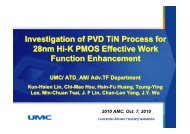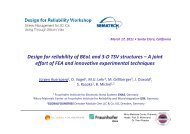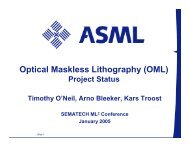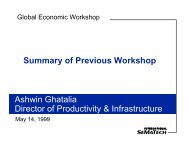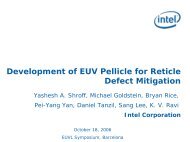Prognostics and Health Management (PHM) - Sematech
Prognostics and Health Management (PHM) - Sematech
Prognostics and Health Management (PHM) - Sematech
You also want an ePaper? Increase the reach of your titles
YUMPU automatically turns print PDFs into web optimized ePapers that Google loves.
Accelerating Manufacturing Productivity<br />
<strong>Prognostics</strong> <strong>and</strong> <strong>Health</strong> <strong>Management</strong><br />
(<strong>PHM</strong>)<br />
David Stark<br />
David.stark@ismi.sematech.org<br />
512-356-3278<br />
eMfg WS July 14 2010<br />
Copyright ©2009<br />
SEMATECH, Inc. SEMATECH, <strong>and</strong> the SEMATECH logo are registered servicemarks of SEMATECH, Inc. International SEMATECH Manufacturing Initiative, ISMI, Advanced Materials Research Center<br />
<strong>and</strong> AMRC are servicemarks of SEMATECH, Inc. All other servicemarks <strong>and</strong> trademarks are the property of their respective owners.
Agenda<br />
• What is <strong>Prognostics</strong> <strong>and</strong> <strong>Health</strong> <strong>Management</strong> (<strong>PHM</strong>)?<br />
• What is ISMI doing in the <strong>PHM</strong> arena?<br />
– ISMI Predictive Preventive Maintenance Project (PPM)<br />
– Project Scope<br />
– Project History<br />
– Project Status<br />
– Project Look-Ahead<br />
– PPM resources<br />
• Why should JPWG care?<br />
• Q&A
What is <strong>Prognostics</strong> <strong>and</strong> <strong>Health</strong> <strong>Management</strong><br />
· <strong>Prognostics</strong> & <strong>Health</strong> <strong>Management</strong> (<strong>PHM</strong>) — The discipline that links<br />
studies of failure mechanisms to system lifecycle management. <strong>PHM</strong><br />
uses information to allow early detection of impending or incipient faults,<br />
remaining useful life calculations, <strong>and</strong> logistical decision-making based<br />
on predictions.<br />
· The objective of <strong>PHM</strong> is to maximize equipment return on investment. A<br />
<strong>PHM</strong> system will optimize scheduled maintenance, predictive condition<br />
based maintenance, <strong>and</strong> non-predictive condition based maintenance<br />
to an operational objective.<br />
· Scheduled maintenance is performed on a fixed, calendar-based schedule.<br />
· Non-predictive condition-based maintenance is accomplished by<br />
instantaneous monitoring of equipment <strong>and</strong> by performing maintenance<br />
when an equipment health indicator reaches a predetermined threshold.<br />
· Predictive condition based maintenance is accomplished through acquiring<br />
relevant equipment <strong>and</strong> factory data <strong>and</strong> applying an equipment<br />
degradation model to predict the equipment’s RUL.<br />
· A <strong>PHM</strong> system will combine scheduled maintenance, condition-based<br />
maintenance, <strong>and</strong> predictive maintenance to enable effective cost<br />
versus performance decisions.
Who is already doing <strong>PHM</strong>?<br />
(in other industries)<br />
• <strong>PHM</strong> is famous in<br />
– Automotive industry<br />
• in the modern automobile,<br />
especially the engine<br />
• Toyota in the car/truck assembly<br />
line<br />
– Aeronautics<br />
• GE & Rolls Royce aircraft engines<br />
– Defense <strong>and</strong> Space programs<br />
• Advanced fighter jet<br />
• NASA <strong>and</strong> International Space<br />
Station<br />
– Heavy Industry<br />
• John Deere, Komatsu in earth<br />
moving equipment<br />
• Power plant generators
<strong>PHM</strong> for the Semiconductor Industry<br />
• <strong>PHM</strong> for semiconductor factories will apply mathematical<br />
models to equipment <strong>and</strong> factory data to predict tool failure<br />
<strong>and</strong> then act on those predictions to optimize factory<br />
productivity<br />
– <strong>PHM</strong> will be developed for key equipment where<br />
• Technically possible, <strong>and</strong><br />
• Adequate business value exists<br />
• This is NOT every tool<br />
– At/near the Equipment level, the system will monitor tools <strong>and</strong><br />
predict failures<br />
– At the Factory level, the system will make business rule based<br />
decisions about scheduling PM, parts, personnel, <strong>and</strong> WIP
Fab Information & Control Data<br />
• Parts Inventory<br />
• WIP<br />
• Factory Schedule<br />
• Staffing<br />
13 July 2010<br />
<strong>PHM</strong> Integration<br />
Decision Application<br />
Functions Libraries<br />
Predictive CBM System<br />
Functions<br />
Equipment Data<br />
• Equipment Raw Data<br />
• OEM defined <strong>Health</strong> Indicators<br />
DCP Or<br />
Collect All Data<br />
Libraries<br />
Scheduled PM Application<br />
Functions<br />
Non-Predictive CBM System<br />
Functions<br />
Libraries<br />
Factory/Metrology Data<br />
• MES Process Data<br />
• Defects<br />
• Parametric<br />
• Yield Parameter<br />
DCP Or<br />
Collect All Data<br />
Libraries<br />
Process Equipment Metrology Equipment
<strong>Health</strong> Dashboard View<br />
• Interpretation<br />
13 July 2010<br />
Production planning<br />
Maintenance planning<br />
TOOL 0.7<br />
EFEM 0.9 PM1 0.9 PM3 0.65<br />
PM2 0.4<br />
GAS<br />
BOX 0.9<br />
• The tool is performing OK with an <strong>Health</strong> at 0.7<br />
• The EFEM <strong>and</strong> PM1 are in great shape – <strong>Health</strong> 0.9<br />
PUMP 0.7<br />
• The PM3 is starting to perform worse with <strong>Health</strong> 0.65<br />
• The PM2 is failing with <strong>Health</strong> 0.4<br />
RF 0.3<br />
VAC<br />
CTRL 0.8<br />
GEN 0.3 MATCH 0.7<br />
• Drill down on PM2 shows the problem is in RF subsystem, <strong>and</strong> specifically the RF<br />
Generator needs replacement<br />
• The RF Generator is the lowest level as the RF Generator is the FRU – the thing you<br />
change as a unit when the failure occurs
<strong>PHM</strong> Data to Information to Decision<br />
Select tools<br />
Scheduler – WIP, PM<br />
Resources<br />
WIP<br />
Equipment<br />
$$$<br />
Optimization<br />
- WIP & Maint<br />
PM<br />
&Metrology Data<br />
Raw Data<br />
- Features<br />
Prediction Models<br />
- Planning Info<br />
&Maintenance Record<br />
PCA, Fisher<br />
- Feature Importance<br />
<strong>Health</strong> Models<br />
- Actionable Info
IC Industry <strong>PHM</strong> Status & Issues<br />
• Current state of implementation of this capability in volume manufacturing<br />
– IDM FDC spot solution using commercial application <strong>and</strong> framework & OEM<br />
custom non-st<strong>and</strong>ardized on-board equipment diagnostics, unconnected<br />
– Predictive Maintenance efforts are gaining momentum at OEMs internal<br />
programs, but are not yet commercial, <strong>and</strong> are not st<strong>and</strong>ardized<br />
– Prognostic modeling has not been successfully demonstrated in IC production<br />
– ISMI PPM project will provide proof of concept on a few key tools<br />
– Integration with factory planning systems for WIP <strong>and</strong> PMs is difficult<br />
• Requirements needed to support this capability<br />
– St<strong>and</strong>ards <strong>and</strong>/or guidelines are needed for this capability<br />
• Some guidelines have been produced by ISMI (see Resources slide)<br />
– Data completeness, availability, data st<strong>and</strong>ardization (e.g. EDA)<br />
– Proven predictive algorithms, mathematical models<br />
• Known issues that impede implementation of this capability<br />
– OEM IP <strong>and</strong> IDM IP concerns about data for <strong>PHM</strong><br />
– Commercialization <strong>and</strong> implementation paths for <strong>PHM</strong><br />
– Factory architectures are customized
<strong>PHM</strong> Benefits & Effects<br />
· Optimization scenarios can be written to maximize equipment<br />
availability, reduce costs, increase net WIP output…<br />
· <strong>PHM</strong> can increase consistency in decision-making – data driven<br />
· Reduced unscheduled repairs accomplished by the <strong>PHM</strong> system<br />
constantly monitoring <strong>and</strong> reporting equipment health to the factory.<br />
· Usage-based or scheduled maintenance may, with <strong>PHM</strong>, only be<br />
performed only when the equipment condition warrants it – may<br />
extend PM cycles.<br />
· The <strong>PHM</strong> system identifies the root cause of imminent failure.<br />
· Reduction of diagnosis <strong>and</strong> repair time, reduces MTTR <strong>and</strong> labor<br />
cost<br />
· Only the failing parts are replaced, only at the end of their life,<br />
reducing parts cost<br />
· The increased availability of equipment also enables higher factory<br />
output <strong>and</strong>/or reduced tool <strong>and</strong> labor count, reducing the cost per<br />
wafer
ISMI PPM Project in NGF Program<br />
• Since 2007 ISMI has had a project called Predictive<br />
Preventive Maintenance (PPM).<br />
• The project explores using equipment <strong>and</strong> factory data to<br />
monitor equipment health <strong>and</strong> predict failures before<br />
they occur.<br />
– In 2009-2010, the project is managing 2 pilots, each executed by<br />
a team made up of a key equipment supplier {tool expertise} plus<br />
an ISMI member company {factory data access} plus a<br />
University Researcher {advanced mathematics}. The pilots will<br />
conclude in 2010.<br />
• The project also explores integration of factory systems<br />
to optimize maintenance scheduling (FDC, Scheduled<br />
Maintenance, Condition Based Maintenance (CBM),<br />
Predictive Maintenance, WIP <strong>and</strong> Inventory Scheduling,<br />
as proposed for 2011+.
PPM Project Scope<br />
• Through 2009, the PPM project scope was to define the<br />
<strong>PHM</strong> concept for the semiconductor industry via member<br />
company <strong>and</strong> supplier community consensus using:<br />
– Member company working group<br />
– Supplier forum<br />
– Workshops<br />
– Output was documentation – Vision, Implementation Guideline,<br />
White Paper, Data Requirements, Benefits Modeling<br />
• From mid-2009 to end of 2010, the PPM project scope has<br />
been focused on performing proof of concept pilots using<br />
real data from production tools.<br />
– Output is pilot reports & benchmarking reports & some software &<br />
some IP.
Timeline of project history<br />
2007 2008 2009 2010 2011<br />
Vision Document<br />
Equipment<br />
Implementation<br />
Guideline<br />
PPM Research<br />
White Paper<br />
PPM<br />
Implementation<br />
Guideline<br />
PPM Cost<br />
<strong>and</strong> Cycle<br />
Time<br />
Pilot 1&2<br />
Demo Reports<br />
PPM Data<br />
Requirements<br />
Pilot 1<br />
Final Report<br />
Pilot 2<br />
Final Report<br />
OEM<br />
Benchmark<br />
Report
Pilot 1 Status<br />
• Data:<br />
– 1 PECVD TEOS tool platform<br />
– 9.5 months of production data from MC fab<br />
– Maintenance records <strong>and</strong> metrology data (thickness per wafer,<br />
particles, quals (thickness <strong>and</strong> RI))<br />
• Build model to predict time to failure for chamber<br />
performance shifts between observable <strong>and</strong> nonobservable<br />
states (Hidden Markov, Markov, Match Matrix<br />
models)<br />
• Build hardware hierarchical view of tool health dashboard<br />
for process chamber <strong>and</strong> associated hardware<br />
• Expected completion is late 2010.
Pilot 2 Status<br />
• Data:<br />
– 4 Plasma Etch tool platforms x 2 chambers = 8 chambers<br />
– 8 months of production data from fab >3TB<br />
– Maintenance records <strong>and</strong> metrology (etch rate, CD, particles) data<br />
• Build model to predict time to failure (RUL=remaining useful life)<br />
for 3 costly, low frequency key maintenance events<br />
1. ESC failure<br />
2. Vacuum leak {injector seal, window seal, chamber iso valve}<br />
3. Wet Clean {chamber hardware element wear is root cause}<br />
• Build hardware hierarchical view of tool health dashboard for<br />
process chamber <strong>and</strong> associated hardware<br />
• Using existing tools <strong>and</strong> knowledge owned by University through<br />
~10 years of consortium. Their tools <strong>and</strong> our data.<br />
• A large variety of models considered for health <strong>and</strong> each<br />
prediction: PLS, SOM, etc<br />
• Expected completion is late 2010.
<strong>PHM</strong> Project Look-Ahead - 2011<br />
The <strong>PHM</strong> 2011 proposal includes:<br />
– performing more pilots at the equipment level (more of<br />
same),<br />
– developing <strong>and</strong> piloting the decision application, <strong>and</strong><br />
– developing common component models
PPM Resources from ISMI<br />
• Information to be declassified<br />
– 4 publications with general guidelines<br />
• Vision 2007<br />
• Equipment Implementation 2008<br />
• Integrated Implementation 2009<br />
• Data Requirements 2009<br />
• Public Workshops:<br />
– PPM Public Workshop in San Francisco ~ July 2008<br />
– PPM Workshop (class type) ISMI Symposium<br />
November 2010
Questions <strong>and</strong> Answers



